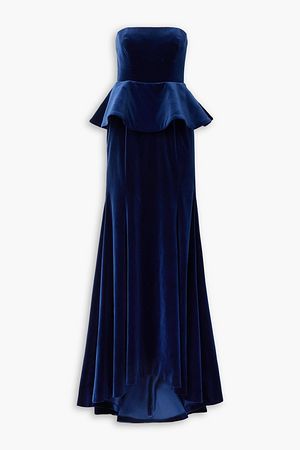The Icons - The Gown
THE GOWN
Sometimes fashion is about throwing practicality to the wind and embracing shameless romance, glamour and fantasy. The gown represents just that – a sartorial embodiment of opulence and fairytale-like transformation. For trans model, writer, speaker and activist Munroe Bergdorf, this most dramatic member of the dress family has a strong emotional pull. Here, she writes a love letter to the gown and describes how wearing one gave her the freedom to embrace who she is.


As far back as I can remember, I’ve found myself drawn to glamorous silhouettes, bold displays of femininity that tell a story of defiance in a straight, cis, masculine-dominated world. From fictional characters of film and stage to iconic moments on runways and in music videos, to the real women of every day celebrating landmark moments in their lives, the gown has always captured my attention and imagination.
While a gown is a dress, not all dresses are gowns. There is more to the chemistry of this style than the obvious intricacy of its construction, price point and luxury fabrics. There is something inherently powerful about it, for both wearer and witnesses. Different silhouettes come and go, but the way a gown makes us feel is timeless. Whether an evening gown, ball gown, or wedding gown, we’ve all seen the confidence exuded by a woman who has found the perfect style that not only accentuates her form but amplifies her energy.
The first person I saw wearing a gown that made a lifelong impression on me was Anjelica Huston playing the iconic role of Morticia Addams. From the signature mermaid tail to the dramatic cascading sleeves and corseted waist, it is simply timeless, instantly identifiable, and often referenced. The costume design for Huston’s portrayal of Morticia, much like Carolyn Jones (who also played the character) before her, was perhaps my first example of how fashion can be used to tell a story about who the wearer is. The gowns are as much a part of Morticia as she is a part of them, a true masterclass in how to join forces with a gown and not simply just wear it, or worse still, let it wear you.
Later in my teens, it was discovering the exaggerated forms and camp exuberance of Manfred Thierry Mugler’s designs that furthered my love affair with gowns. Complemented by the uncompromisingly powerful runway walks of supermodels such as Linda Evangelista, Claudia Schiffer and Kristen McMenamy, Thierry’s pieces challenged what I thought fashion was, who it was for, what role it could play in my own life and how I wanted to express myself in the future.

In my twenties, it was the dark and otherworldly wonder of Alexander McQueen’s gowns that urged me to dream. I loved the evocative Oyster dress of his spring/summer 2003 Irere collection, made of ivory silk organza, chiffon and georgette and worn by the legendary Kate Moss, who floated hauntingly mid-air in the form of a hologram projected above a captivated audience. The piece would later be described as one of the most important dresses of the 21st century.
It wasn’t until I began my own modelling career that I was given a taste of how it felt to wear a gown. I had just begun my transition and, although I had always felt that my inner femininity was a source of personal power, I hadn’t yet had the opportunity to wear garments that allowed me to express it externally to such a grand degree. It was my first time ever wearing couture; I remember the gown so clearly – a black sweetheart bustier, with hourglass padding, covered in black feathers that descended into a dramatic mermaid train. I had never felt as glamorous as I did that day on set, I didn’t want to take it off. I instantly wanted more.
Today, I’m unsure of exactly how many gowns I own, but I have certainly accumulated my fair share. My favorite has to be the custom-made Robert Wun design that I wore to The Fashion Awards in 2021. I felt like a majestic bird of paradise on that red carpet, with the sprawling green wings undulating behind me as I made my way up the steps of the Royal Albert Hall. But I love all of the gowns I own in different ways, for the memories that they have provided me with, the fantasy that they encouraged me to embody, and the freedom they gave for me to celebrate who I am.
Pre-pandemic, the idea of being overdressed at events felt like much more of an immediate concern than in these times that we have found ourselves in. Like so many people who struggled with the drab isolation of lockdown, I began to look at glamour as less as of a frivolous exercise of excess and more as an escape into fantasy. From Galvan to Monique Lhuillier, I jumped at the chance to wear my favorite gowns at the first opportunity once out of isolation. After what felt like an eternity of being sat on my sofa in sweatpants, I fell back in love with dressing up in a similar way to how I had in my childhood. Yet again, the gown began to represent an image of freedom.
Whether the classic cinematic elegance of Monica Bellucci or the outlandish and avant-garde looks of Lady Gaga, the common thread that runs throughout all of my best-loved gown wearers is their belief in the moment that they are part of. If you’re worried about being overdressed in a gown, first it is important to understand that gowns are inherently statement pieces. Don’t let the statement wear you, wear it! Embrace it. Enjoy it. Stepping into a gown is like stepping into an aspect of our character that rarely gets to shine. Embrace the moment and believe in your fantasy.
Transitional, published by Bloomsbury, £13.75, is available to pre-order from Amazon now.



